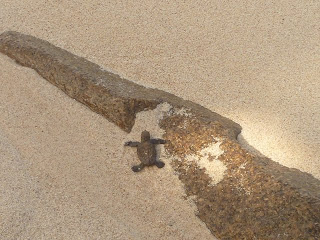MCSS Senior Researcher Laura Jeffreys describes the discovery of some of Seychelles rarest turtles....
For some while now MCSS have been implementing a project funded by Mangroves for the Future on protecting coastal bio-diversity. As a component of this, we have been searching the wetlands, streams and freshwater ponds around Beau Vallon, Mahé for native mud turtles.
One of the BeauVallon wetland areas, ideal mud turtle habitat...
The search commences every evening just before dusk when we ‘the MCSS team’ place a modified traditional Seychellois fish trap in a freshwater pond/wetland. To encourage the mud turtle into the trap, a tin of tuna in oil is placed inside. The oil helps the smell of the tuna to carry across the freshwater.
Gareth Jeffreys has the important and dangerous role of placing the fish trap. This involves securing the fish trap to ensure it is able to float in a set position whilst still providing air to the mud turtle should they enter the trap (as they require air to breathe). The dangerous element is that we like to place the fish trap out of sight to prevent it being visible to passers-by and on this occasion meant that Gareth had to balance precariously on an old rotten fallen log. Gareth successfully balanced himself and has yet to experience falling in!
As usual, we patiently wait overnight (as does the mud turtle should it have entered the fish trap). At 6am, we wake up eagerly with the hope of a mud turtle. Gareth, once again expertly balances on the log to retrieve the fish trap. Abi March and myself wait in anticipation for whichever comes first: either the first sighting of the mud turtle through the fish cage; or the confirmation call from Gareth. We both glowingly received Gareth’s verification that we had a small crab and a mud turtle. The MCSS Team were all particularly delighted as during our journey to the freshwater pond, Abi had predicted either three mud turtles or none!!! Obviously, we hadn’t liked the sound of these odds. Thankfully, Abi’s prediction was wrong.
An endemic yellow-bellied mud turtle from Beau Vallon
It was a yellow-bellied mud turtle also known has chestnust-bellied mud turtle (Pelusios castanoides ssp. Intergularis) which is categorised as ‘critically endangered’ on the IUCN Red List. We checked on the sex of the yellow-bellied mud turtle by checking the length of the tail and confirmed he was a male. His measurements were as follows: length of 20cm, width of 13.5cm and carapace length of 22.2cm. The carapace is the top of the shell which is an arc shape.

Gareth taking note of Gold Finger's vital statistics
In order for us to be able to tell that we have already taken this mud turtle’s measurements, we marked him with gold nail varnish before releasing him back in his pond to help us ID him in the future, hence the name Gold Finger!
Gareth releasing GoldFinger, without falling off the log!
Although protected by Seychelles Law, the population is deemed to be decreasing and threats to the species include habitat loss through drainage of wetlands, as well as reduced quality of habitats due to pollution and rubbish dumping. Unfortunately, the location of where we found Gold Finger appears to be a dumping ground for disused household goods like fans and even a washing machine.
I’m not sure if I have successfully described our delight but to provide you with some context may help. We were particularly ecstatic as the yellow-bellied mud turtle is native to Seychelles and is critically endangered: “...endemic to islands in the Seychelles. It is found on Mahé, Cerf, Praslin, La Digue, Fregate and Silhouette islands… In 2002, the total population was estimated at less than 100 adults, distributed throughout six isolated populations” (IUCN 2011).
As you may now appreciate, we were a very happy MCSS team knowing to have found one yellow-bellied mud turtle, Gold Finger, from an estimated population of less than 100!
Post Script: Another two yellow bellied mud turtles were captured from the same site two days after ‘Goldfinger’, one of which was over 1.5cms bigger than Goldfinger... so that's three out of the expected population of 100!
The two latest yellow-bellied mud turtles!








































 The Intendance area is also one of the four sites being used in a new study being implemented by MCSS and GIF to provide better environmental information to both local communities and technical experts to assist the planning process. This project is the first Large Project funded by the Mangroves for the Future in Seychelles and will be on-going for 24 months and we will keep you updated of activities.
The Intendance area is also one of the four sites being used in a new study being implemented by MCSS and GIF to provide better environmental information to both local communities and technical experts to assist the planning process. This project is the first Large Project funded by the Mangroves for the Future in Seychelles and will be on-going for 24 months and we will keep you updated of activities.








